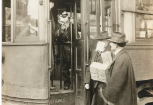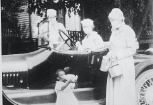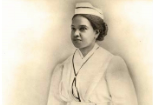





THE CHARLESTON RENAISSANCE
1912 - 1940
1912
Sept. 5 -- A tropical storm moved southwest off the South Carolina coast before weakening into a tropical depression and making landfall on Ossabaw Island, Ga.
1913
Oct. 7 -- A Category 1 hurricane made landfall on Cape Island, just north of Charleston. Over the next three days it produced up to 4 inches of rainfall in Charleston and even more in the Pee Dee area of the state.
1916
May 15 -- The Lowcountry's earliest landfalling tropical storm on record came ashore on Fripp Island.
1918
Jan. 3 -- Mary A. Storfer, the new proprietress of the Timrod Inn (formerly the Commercial Club, afterwards known as the Timrod Hotel), announced in the News and Courier: "Many people have told us that the Timrod Inn fills a distinct place in the community, and indications are that our rooms will be in demand from the beginning. We shall open Monday morning and guests will be given desirable accommodations without delay."
Sept. 16 -- The first case of the Great Spanish Influenza's arrival in Charleston was documented at the Navy Base. The Navy immediately imposed a quarantine on the base.
Sept. 18 -- Depsite the quarantine put in place on Sept. 16, 350 cases of the Spanish Influenza had been reported at the Navy Base.
Sept. 30 -- The Evening Post ran an article on the recent outbreak of the Spanish flu, saying ". . . the best thing to do is to avoid public gatherings as much as possible, walk to work in the morning rather than be exposed to a crowded conveyance [such as a trolley].”
Oct. 1 -- In a news article about the Spanish Flu, government officials said, “The disease itself is not so dangerous . . . .The danger lies in the careless spreading of the disease, and careless treatment, allowing pneumonia or other dangerous maladies to develop."
Oct. 3 -- Despite medical officials' warnings about the Spanish flu, S.C. Gov. Richard Manning joined a crowd of Charlestonians at a military parade on Marion Square to encourage popular support for the Liberty Loan program, a fundraiser for the war effort. Later that afternoon, the College of Charleston suspended classes and sent everyone home. Local public schools sent home children with symptoms of being sick.
Oct. 6 -- Charlestonians finally began to understand the seriousness of the pandemic. The city's mayor then mandated the immediate closing of "all churches and Sunday schools, public and private schools, theatres, movie houses, pool rooms, public and private dances, secret and fraternal associations, sewing circles, card parties, and all other places and forms of congregation." Officials, however, continued fundraising door-to-door for the Liberty Loan program.
Oct. 12 -- State officials made its stashes of seized bootleg whiskey available to those with the flu, to be administered only by the Red Cross and only by prescription.
Oct. 14 -- To assist those struggling with the flu, the city opened a public kitchen at Memminger Normal School on Beaufain Street, where families could receive three healthy meals a day.
Oct. 21 -- The official count of the ill reached its peak with 5,064 cases, including 130 deaths.
Oct. 22 -- Reports of new flu cases began to recede.
Nov. 6 -- The last of the Memminger kitchen meals was served. Between Oct. 14 and Nov. 6, the kitchen had served an estimated 5,677 meals, or 242 a day.
Nov. 7 -- The city ended its mandated flu quarantines, with the exception of the public schools and the Navy Base,
Nov. 11 -- The Navy Base ended its flu quarantine. The same day the U.S. declared victory in World War I.
1928
Nov. 24 -- The cornerstone for a new bank was laid at the historic former site of Shepheard's Tavern at the northeast corner of Broad and Church streets.
1929
Jan. 15 -- Joseph "Big Joe" Gawrych was born in North Haven, CT. According to his obituary in the Post and Courier, after his Navy service he and his Charleston bride settled in Mt. Pleasant, where he coached 11- and 12-year-old boys' baseball for more than 45 years. The Joe Gawrych Baseball Park in Mt. Pleasant is named in his honor. He also planted gardenias on Charlotte Street in the 1970s which have beeen propagated across the Southeast ever since.
April 6 -- Preservationist Peter McGee was born.
1930
May 5 -- Arthur Trezevant Wayne died.
1931
Oct. 13 -- City Council created America's first historical zoning ordinance, protecting its 18th century core from demolitions and establishing the city Board of Architectural Review.
1933
Sept. 16 -- Marilyn Smith (m. Weeks) was born in Charleston, the daughter of Julian Allen Smith and Lucille Pieper Smith. She grew up in Old Windermere, graduated from St. Andrews High School, and attended the College of Charleston. In 1953 she was crowned Miss Charleston.
1935
Oct. 7 -- Porgy & Bess, an opera by George Gershwin based on the novel Porgy by DuBose Heyward, opened on Broadway. Telling the story about the lives of African-American tenants who lived on "Catfish Row," the play ran for 124 performances. The plot prominently features the lifes of members of Charleston's famed Mosquito Fleet.
1936
Nov. 23 -- Life magazine, created by Henry R. Luce, was first published.
1937
July 30 -- The Rev. Daniel Jenkins died.
1939
Sept. 16 -- The last prisoners to be housed in the Old City Jail on Magazine Street were escorted out. (Source: Abode of Misery, p. 15)
1940
May 31 -- The Scottish Rite Cathedral sold the Rodgers Mansion at 149 Wentworth Street to the Atlantic Coast Life Insurance Company.





